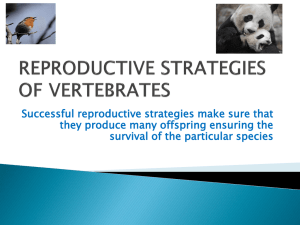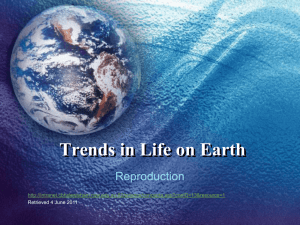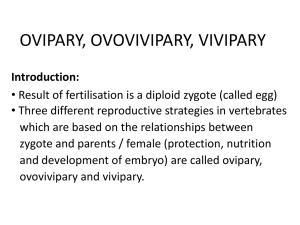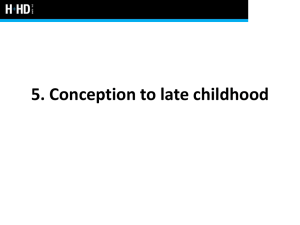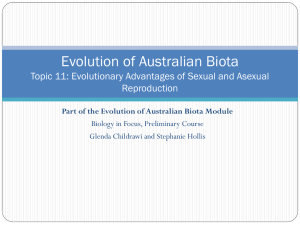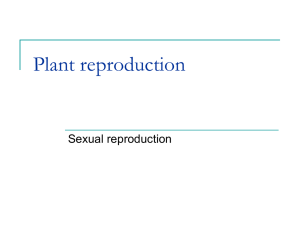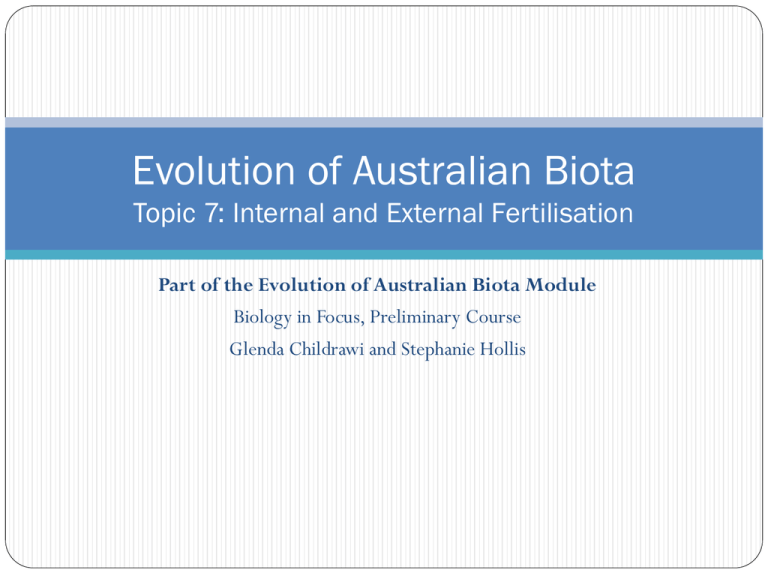
Evolution of Australian Biota
Topic 7: Internal and External Fertilisation
Part of the Evolution of Australian Biota Module
Biology in Focus, Preliminary Course
Glenda Childrawi and Stephanie Hollis
DOT Points
Compare and contrast external and internal fertilisation
Discuss the relative success of these forms of fertilisation in relation to
the colonisation of terrestrial and aquatic environments
Describe some mechanisms found in Australian fauna to ensure
Fertilisation
Survival of the embryo and of the young after birth
Introduction
In animals, the union of male and female gametes (sperm and
ova) can occur outside the body (external fertilisation) or
inside the body (internal fertilisation).
asianelephantresearch.com
External Fertilisation
Many marine organisms carry out external fertilisation as the
water environment allows the union of gametes to occur
without dehydration. Coral for example release large
amounts of gametes at the same time in the hope that some
will be fertilised and then survive until adulthood.
coralcoe.org.au
External Fertilisation
The females of most species
of bony fish produce eggs
(ova) in large batches and
release them into the water.
This is generally followed by
the males releasing their
sperm into the area of water
containing the eggs. This is
how and where the union of
gametes occurs.
science.nayland.school.nz
External Fertilisation
When fertilisation occurs in
the ocean gametes tend to
disperse quickly so the release
of large numbers of eggs and
sperm must occur almost
simultaneously. This is why
most marine fish restrict the
release of gametes to a few
brief and clearly determined
periods.
arthursclipart.org
External Fertilisation
Although thousands of eggs are fertilised in a single mating of
bony fish, many of the resulting offspring succumb to
microbial infections or predation, and few grow to maturity.
learningcommunity202.org
External Fertilisation
The amphibians invaded the land
without fully adapting to the
terrestrial environment, so their
lifecycle is still tied to the water.
Gametes from both males and
females are released through the
cloaca. Among the frogs and
toads, the male grasps the female
and discharges fluid containing
sperm onto the eggs as they are
released into the water.
moorhen.me.uk
Internal Fertilisation
The invasion of vertebrates onto land
posed a new danger of dehydration.
The gametes could not simply be
released near each other as they
would quickly dry up and perish. This
led to the evolving of internal
fertilisation and copulation where the
male gametes are inserted into the
female reproductive tract.
fivetooltool.blogspot.com
Internal Fertilisation
This allows the union of gametes to occur in a moist
environment, even though the animal is on land. It also
protects the offspring from predation or dispersal. This means
that fewer eggs are required to ensure a successful number of
offspring survive.
seanthomas.net
Internal Fertilisation
Most reptiles fertilise their eggs internally and then the eggs
are deposited outside the mothers body for development.
Male reptiles use a tubular organ, the penis, in inject sperm
into the female.
seanthomas.net
Internal Fertilisation
All birds practice internal fertilisation, though most male
birds lack a penis. As the egg passes along the oviduct, glands
secrete proteins (egg white) and a hard calcium carbonate
shell that distinguishes bird eggs from reptile eggs. Most birds
incubate their eggs after laying them.
flickr.com
Internal Fertilisation
Some mammals are seasonal breeders, reproducing only once
a year, while others have shorter reproductive cycles. Cycling
in females involves the periodic release of mature egg (ovum)
from the ovary (ovulation). Mammals require the insertion of
sperm into the females reproductive tract (copulation) for
fertilisation to occur.
wildlife-pictures-online.com
Success of Fertilisation
Organisms in aquatic
environments are highly
successful in their
reproduction and survival as
they have adaptations suited to
reproducing in this type of
environment. However, this
also means that they are
completely dependent and
reliant upon their environment
providing the water required
for successful external
fertilisation.
desertsurvivor.blogspot.com
Success of Fertilisation
In order to survive on land, organisms needed to overcome
the dependence on aquatic environments for fertilisation by
providing their own enclosed moist environment within the
female reproductive tract.
walkaboutpark.com.au
Success of Fertilisation
Flowering plants have colonised the land by fertilisation
internally and avoiding gamete desiccation. Reptiles have also
colonised the land successfully by producing adaptations to the
dry environment by carrying out internal fertilisation and
allowing their young to develop inside a waterproof egg to
protect from desiccation.
surrey-arg.org.uk
Success of Fertilisation
Even further, mammals
allow internal development
of their young after internal
fertilisation has occurred.
This ensures successful
reproduction and survival
of the respective species in
colonising the land.
superstock.com
Success of Fertilisation
Internal fertilisation has only been possible on land because of
overcoming the need for water. This method is very successful
as the mechanism for direct transfer of gametes avoids
dehydration and loss by dispersal, so fewer female gametes are
required.
dazzlebox.net
Success of Fertilisation
The success of this form of
fertilisation is very high as the
environment is enclosed in a
confined space protected from
predation and disease. Even
the driest environments can
be colonised successfully by
using this method.
faradayschools.com
Activity
Hand out copy of Table 3.2 in Prelim Bio in Focus Text (pg285)
-Students to complete: 1.7.1 Comparing Internal and External
Fertilisation Table

